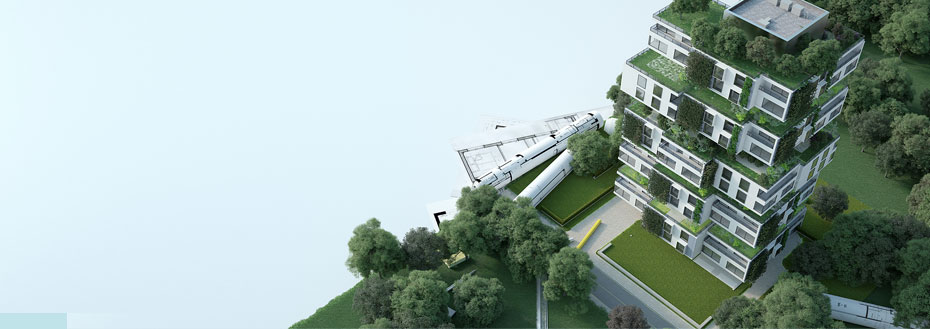Full disclosure from Dodge Data & Analytics and United Technologies Corporation, as well as the World Green Building Council, calls attention to the prevalent challenges that are getting in the way of countries adopting the green building market. Up to 70% of survey takers from 11 countries voted higher initial cost as the number one stumbling block while 48% believed it was a lack of public awareness. Then, there were 60% who considered the lack of political will to be the reason and lastly, 42% opined the perception that Green is only for high-end projects to be the reason.
If one went by the numbers it's evident that there is a gap in many areas that is wide enough to prevent the sustainable green home goals to culminate in success. Perhaps, we are not on the cusp of major transformation as most nations don't yet have a collective agreement on the process. So stick around till the end of this compilation of top 10 ways on how to create sustainable & futuristic green home design.
Top 10 Sustainable Architectural Designs for the Present and Future
Going by the present challenges, the reformative thinking and actions towards it is a long-drawn process and it must begin by addressing local challenges before thinking outside of the boundaries. So here are sustainable architectural strategies followed by architects -
-
Active Sustainable Design

The role of an architect while planning sustainable designs is to minimize carbon footprint and reduce energy consumption. To begin with, they must collaborate with mechanical engineers to optimize HVAC, plumbing, and electrical designs. These can have an instant impact on regulating energy demands. When done with care and precision you'll have a design that auto regulates ambient conditions without depending on fossil fuels or other finite energy sources.
-
Passive Sustainable Design

Designing a climate-controlled interior is a complex process it requires knowledge of making static parts eco-friendly. Expert engineers plan window placement in a way to allow flooding of interiors with natural light so the need for illumination with artificial light can be limited to late evenings. A well-planned insulation model regulates room temperature in all seasons without the need for airconditioning. One of many simplest ways to regulate climate is to have thicker walls. It retains heat from the daylight and bleeds it during the night to warm up the interior.
-
Renewable Energy System

Harnessing free energy is ever-important in the Green Revolution. If the higher perceived first cost can be overcome, you'll have the cleanest energy powering energy-hungry real estate. Wind and Solar farms must be given prominence in both residential and commercial settings. If these are effectively implemented, the dependence on fossil fuels can be greatly shrunk.
-
Stormwater Management

The importance of replenished water tables must be greatly discussed and with a push from the government, rampant urbanization can be regulated. It's only natural for unevaporated rainwater to sink into the ground to fill up groundwater levels. However, RCC structures and impervious paved roads interfere with the natural process. Thus, causing water to run off via drain. The urban population, in need of water, digging borewells causes a rapid imbalance in existing water levels. This too, if regulated, helps to reverse ecological damage. Communities must inculcate the practice of implementing stormwater retention systems to capture runoffs and replenish water tables naturally.
-
Green Building Materials and Furnishings

The philosophy of green home design is to condemn the dependence on materials that aren't eco-friendly. So a professional will look at the market to source sustainable materials like timber, steel, and concrete. Sometimes, they are inspired to think of unconventional materials that are best suited for interior furnishing and floor carpeting. Here, the ability to research is what competency is all about. They are expected to get in touch with companies with a sound reputation for working with sustainable materials.
-
Native Landscaping

If you are in a drier area, you might need to plan the landscaping accordingly to reduce water consumption. By planting native flora and using natural characteristics of the land, the water usage can be regulated. If you've considered already, xeriscaping is a form of energy-saving where water consumption is minimized using rocks and native plants. Especially, if you plant trees, it regulates indoor temperature by providing shade on sunny days.
-
Automation of Energy Consumption

Using smart automation helps you curb wastage of energy as the home automation system monitors live conditions and perform programmed functions to prevent inflated energy bills. Many of these systems are AI-powered and can sense human presence to adjust the ambient conditions accordingly. The simplest example is an automated lighting system that turns off the light when human presence isn't detected in the room.
-
Energy Efficient Windows

In the green home vision, Energy Star windows have found a place because they are highly energy-efficient than typical double pane windows. The Energy Start windows are government rated for efficiency as it suppresses sound penetration from the outdoor. It helps you save hundreds of dollars that are otherwise spent on regulating ambient temperature.
-
Geothermal Power

Not many know the earth beneath them is a giant heat sink and has geothermal energy that's unused. To get started, you may have to soak up a one-time initial expense. Once the system is working, it is a money-saver as year-after-year you begin recovering your investment in the form of an energy-efficient climate control system.
-
Cooling Roofs

Your roof is like an empty canvas if you can use the right material, you could dramatically cut down the expense. The best design is one that reflects the daytime temperature and rapidly cools at night. You can choose from terra cota, membranes, tiles, and much more. Most of these options involve cheap labor to install and even maintain.
Building Design Principles Supporting Sustainable Architecture
To reduce carbon footprint, several things can be done one at a time from the ground above. An architect looks for gaps in existing design and proposes a comprehensive plan that reduces the complexities in maintenance and decommissioning. Here are design principles on which sustainable buildings are based on -
-
Maximizing Site Potential
The focus should be on how to use a site to its ultimate potential by taking into consideration the ecosystem, built-up location. If necessary, make changes in its design to facilitate the economic use of energy. Even aligning the entrance with the road reduces the driving distance.
-
Modest Energy Consumption
The only way to fully align with the green home design is to have zero-energy buildings because it ensures dependency on fossil fuel energy is kept to an all-time low. As part of this philosophy, the architect leverages every part of the building to curb energy dependence. It is not only about limiting consumption but also compensating the demand with cleaner and free energy to improve sustenance through collective actions involving systems, equipment, and material.
-
Conservative use of Water
Water is our planet's crown jewel and we must take the best measures to use it conservatively and ensure replenishment of natural sources that provide us. An example of water conservation is implementing a groundwater recharge system to harvest and reuse rainwater. Also, the excess runoffs must be trapped in ponds and allowed to reach the water table.
-
Effective use of Space and Materials
As our planet's landmass continues to get filled by population and civil constructions, more natural resources are used up for urbanization projects. We will arrive at a juncture, overlooking a crisis due to the depletion of natural resources. To avert this possibility, it's essential to judiciously use available resources and most importantly, turn the attention to recyclable materials and buy materials from brands that follow eco-friendly practices.
-
Improving IEQ (Indoor Environmental Quality)
It's important to prioritize the health of inhabitants by improving the IEQ. One of the ways to inculcate the practice is to make the best use of daylight by placing windows where the light enters and stays the longest. There must also be a provision to control moisture and circulation of natural air. In doing so, you can curb the use of materials responsible for VOC emissions.
-
Efficient Operational and Maintenance Practices
The most important aspect of green building is to reduce the maintenance effort and cost in the long run. To do so, everything from the selection of building materials to automation works best at managing energy and reduce footprint. The list is endless as it goes beyond the obvious aims to smaller things like the use of eco-friendly cleaning compounds to improve the health of residents. In essence, a holistic approach is needed to achieve sustainability goals.
Takeaway - Transformative Thinking and Collective Steps are the Stimuli for Change
It's clear as daylight that there is much work needed to spur the demand and growth of sustainable and future green home design. Despite the green movement gaining traction in most emerging markets worldwide, there are plenty of hurdles in the form of unsupportive government, old regulations, and many other factors that are collectively inhibiting communities from realizing the green goal. Much of the problems are rooted in a lack of transparency, technical skill, and availability of subsidized fossil fuel that people have gotten used to. Then there is a general perception that the green concept is a big-budget project that isn't worth the time of individual homeowners. But if you follow these 10 methods covered above, you could be on your way to creating a sustainable & futuristic green home that will immensely serve present and future generations.
Outsource Architectural Services to Flatworld Solutions
Flatworld Solutions has 22 years of experience in architectural services and we have rendered energy-efficient designs for green homes that don't interfere with the functionality and quality of living. We have always been a proponent of the green revolution and have led from the front on several occasions. Our architectural services focus on enhancing energy efficiency and lowering carbon footprint. To do so, we train our team handpicked from our talent pools and impart tool knowledge and help them achieve certification for becoming qualified professionals.
If there is a need for creating a sustainable and futuristic green home design, don't forget to ping us, Flatworld Solutions will provide you with a friendly quote in 24 hours. Contact us today!
Contact UsAvail best-in-class services at affordable rates
Our Customers





Key Differentiators
Case Studies
-
Flatworld Solutions provided customized CNC programming using MasterCAM
-
Flatworld Provided CFD Simulation Services to a Leading HVAC Products Manufacturer
-
Flatworld Solutions Offered Mechanical Instrument Drafting and Detailing Services to an Engineering Consultant
-
Flatworld Solutions Offered US Client with 2D to 3D Mechanical Legacy Drawing Conversion
-
Flatworld Solutions Provided Reverse Engineering of Machine Parts to a Client
Join the growth phase at Flatworld Solutions as a Partner
Service distributorship and Marketing partner roles are available in select countries. If you have a local sales team or are a person of influence in key areas of outsourcing, it's time to engage fruitfully to ensure long term financial benefits. Currently business partnerships are open for Photo Editing, Graphic Design, Desktop Publishing, 2D and 3D Animation, Video Editing, CAD Engineering Design and Virtual Walkthroughs.
Reach out to us for a quick direct response from decision makers at the Flatworld Solutions global team.

USA
Flatworld Solutions
116 Village Blvd, Suite 200, Princeton, NJ 08540
PHILIPPINES
Aeon Towers, J.P. Laurel Avenue, Bajada, Davao 8000
KSS Building, Buhangin Road Cor Olive Street, Davao City 8000
INDIA
Survey No.11, 3rd Floor, Indraprastha, Gubbi Cross, 81,
Hennur Bagalur Main Rd, Kuvempu Layout, Kothanur, Bengaluru, Karnataka 560077



